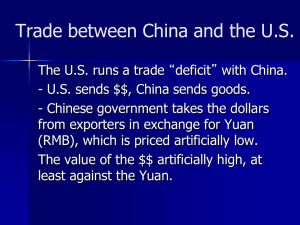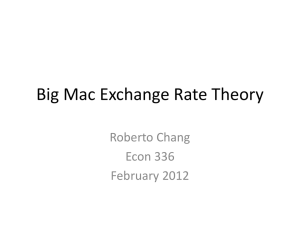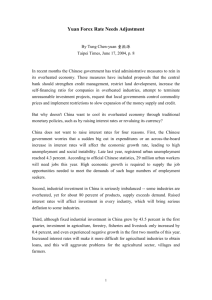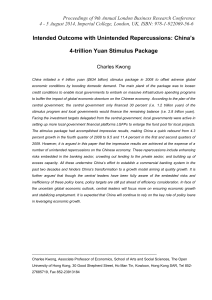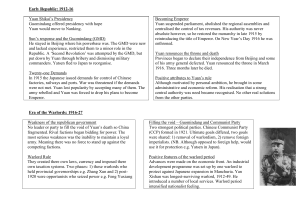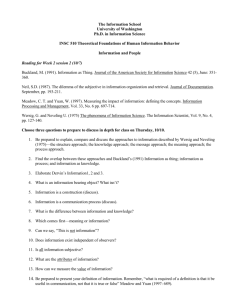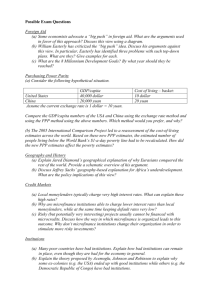Why the Yuan Should be Revalued
advertisement
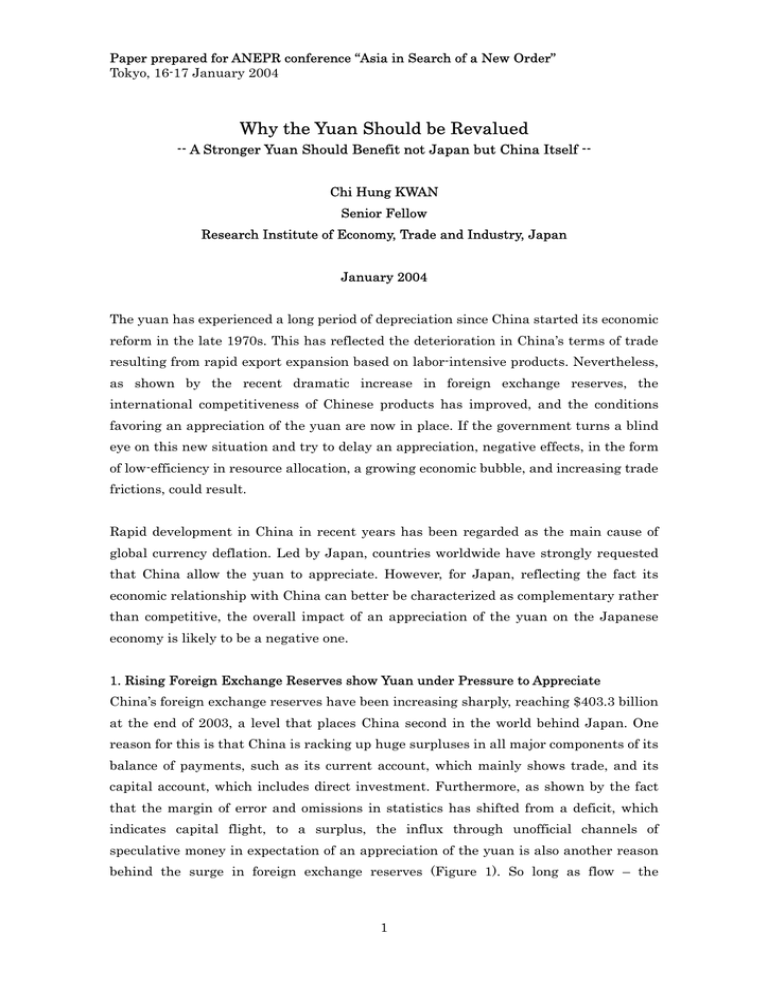
Paper prepared for ANEPR conference “Asia in Search of a New Order” Tokyo, 16-17 January 2004 Why the Yuan Should be Revalued -- A Stronger Yuan Should Benefit not Japan but China Itself -Chi Hung KWAN Senior Fellow Research Institute of Economy, Trade and Industry, Japan January 2004 The yuan has experienced a long period of depreciation since China started its economic reform in the late 1970s. This has reflected the deterioration in China’s terms of trade resulting from rapid export expansion based on labor-intensive products. Nevertheless, as shown by the recent dramatic increase in foreign exchange reserves, the international competitiveness of Chinese products has improved, and the conditions favoring an appreciation of the yuan are now in place. If the government turns a blind eye on this new situation and try to delay an appreciation, negative effects, in the form of low-efficiency in resource allocation, a growing economic bubble, and increasing trade frictions, could result. Rapid development in China in recent years has been regarded as the main cause of global currency deflation. Led by Japan, countries worldwide have strongly requested that China allow the yuan to appreciate. However, for Japan, reflecting the fact its economic relationship with China can better be characterized as complementary rather than competitive, the overall impact of an appreciation of the yuan on the Japanese economy is likely to be a negative one. 1. Rising Foreign Exchange Reserves show Yuan under Pressure to Appreciate China’s foreign exchange reserves have been increasing sharply, reaching $403.3 billion at the end of 2003, a level that places China second in the world behind Japan. One reason for this is that China is racking up huge surpluses in all major components of its balance of payments, such as its current account, which mainly shows trade, and its capital account, which includes direct investment. Furthermore, as shown by the fact that the margin of error and omissions in statistics has shifted from a deficit, which indicates capital flight, to a surplus, the influx through unofficial channels of speculative money in expectation of an appreciation of the yuan is also another reason behind the surge in foreign exchange reserves (Figure 1). So long as flow – the 1 Paper prepared for ANEPR conference “Asia in Search of a New Order” Tokyo, 16-17 January 2004 international balance of payments – remains in the black, stock – foreign exchange reserves – will also continue to rise. Such an expansion in the imbalance is leading to a decline in the efficiency of resource allocation, economic overheating and trade frictions with other countries; and authorities are having difficulty dealing with the situation. Figure 1 China’s Rising Foreign Exchange Reserves ($ billions) 450 400 Foreign exchange reserves 350 300 250 200 Rise in foreign exchange reserves Error and omissions 150 100 Capital account 50 Current account 0 -50 1993 1994 1995 1996 1997 1998 1999 2000 2001 2002 2003* (year) (Note) Increase in foreign exchange reserves = current account balance + capital account balance + error and omissions. * Breakdown of balance-of-payments items for 2003 are estimated based on half-year figures. Source: State Administration of Foreign Exchange http://www.safe.gov.cn/ The increase in the external imbalance vividly shows that the current exchange rate is lower than its market equilibrium rate. China maintains that it has a managed floating system, but the focus of this policy has been on “management,’’ and there has been virtually no “floating’’ in the yuan’s exchange rate against the dollar since the Asian currency crisis of 1997. When, as is the case now, the yuan is comparatively undervalued against the dollar, the supply of dollars exceeds demand, and authorities must issue more yuan to absorb the excess dollars in the market in order to stabilize the exchange rate. If China had been adopting a purely floating system, the central bank would not intervene in foreign exchange markets and, so that the level of foreign exchange reserves would remain unchanged, while the exchange rate would rise so as to 2 Paper prepared for ANEPR conference “Asia in Search of a New Order” Tokyo, 16-17 January 2004 secure a balance between a foreign currency’s supply and demand instead. When, as seen now, authorities try to forcibly maintain an exchange rate that keeps the yuan comparatively undervalued, China’s foreign exchange reserves further increase, and the negative effects stemming from this are already becoming conspicuous. As a result of market intervention by authorities, foreign exchange reserves have grown sharply, but because they have been invested in such foreign assets as U.S. Treasury bonds, the hard currency so painstakingly earned is not used to develop the domestic economy and instead flows to foreign countries. Meanwhile, as a result of market intervention, the domestic money supply has also increased sharply, threatening to accelerate economic overheating. In order to absorb the liquidity brought about by market intervention, authorities are implementing sterilization policies such as open market operations to control the money supply. Specifically, in addition to the central bank’s selling of its short-term bond holdings to absorb yuan, from September 21 the reserve ratio applicable to commercial banks was raised from 6% to 7%. However, as a result of sterilization measures, domestic interest rates are rising, further inducing the influx of hot money. Furthermore, should China do nothing to correct its trade imbalance with major trading partners, trade frictions could worsen. Pressure from the United States to appreciate the yuan may intensify, especially with the presidential election coming up next year. To strive for foreign exchange stability and correct imbalances, authorities have adopted a series of measures to encourage the outflow of foreign currency and stem its influx while maintaining exchange rates through market intervention. First, as a step to encourage foreign currency to flow out of China, restrictions on foreign direct investment by domestic companies have been eased, and ceilings on currency exchange by individuals and their taking of foreign currency overseas have also been raised. In addition, China has dispatched missions to the U.S. to make emergency purchases of aircrafts and automobiles. At the same time, to control the influx of foreign currency, authorities have announced that from January 2004 the tax refund rates for value-added tax will be reduced by an overall average of three percentage points. While value-added tax currently stands at 17%, the refund rate is on average 15%, and the remaining 2% can be considered as an export tax. The upcoming reduction in the refund rate is equivalent to a hike in the export tax, and is expected to have a dampening effect on Chinese exports. 3 Paper prepared for ANEPR conference “Asia in Search of a New Order” Tokyo, 16-17 January 2004 However, measures to encourage the outflow of foreign currency could exacerbate capital flight, and government intervention in the market through such means as emergency imports and raising the export tax could distort the allocation of resources. So long as such measures have these side effects, China should utilize the most direct and effective means to correct the imbalance, which is to adjust its exchange rate. 2. Foreign Exchange Policy Needs to Change with the Times However, Chinese authorities repeatedly stress that there is no need for a stronger yuan, while the Chinese media have kept warning that such demands by Japan and other countries may be a "conspiracy" to block China's economic development. The time seems to be ripe for a revaluation of yuan, so why does China continue to refuse to let it happen? First, the successes of the past have turned into obstacles to new thinking. At the time of the Asian currency crisis of 1997-1998, China worked to stabilize the yuan using its abundant foreign exchange reserves, and thus prevented the crisis from affecting it. By keeping the competitive devaluation among Asian nations in check, this also won China global praise. Chinese authorities have thus come to treat the pursuit of currency stability and accumulation of foreign exchange reserves as ends in themselves rather than policy means. Second, the fundamentals of the Chinese economy remain sound, and authorities do not feel the need to alter macroeconomic policy. Rising foreign exchange reserves usually increase the money supply, leading to higher inflation. The usual prescription for such a situation is to have the currency appreciate in order to stabilize prices. However, in China's case, the increase in the price level has so far remained moderate. Furthermore, in contrast to a situation when a currency is forced to devalue under downward pressure, with foreign exchange reserves now rising, authorities do not find it urgent to take concrete actions. Third, even if the yuan's appreciation is beneficial for the nation as a whole, those groups that will be adversely affected by such a move will oppose it. Specifically, a stronger yuan means that Chinese products will become more expensive in dollar terms, and their international competitiveness will decrease. In contrast, because import prices will fall in yuan terms, sectors at a comparative disadvantage in competition with imports, such as agriculture, as well as inefficient state-owned sectors will likely be 4 Paper prepared for ANEPR conference “Asia in Search of a New Order” Tokyo, 16-17 January 2004 adversely affected. Finally, demands from abroad, including Japan, for the yuan to appreciate have turned foreign exchange policy from being a domestic economic issue into an international political matter. However, now that economic circumstances both at home and abroad have greatly changed, the time has come for a review of the foreign exchange policy that has so far worked so well. By pointing out the errors of judgment in the points mentioned above, I would like to present my case as to why the yuan should appreciate. First, at the time of the Asian currency crisis other countries wanted the yuan to be stable, that is, to not depreciate. However, at present, the international community is criticizing the yuan's stability - the fact that it is not appreciating. As Japan, Europe and the United States see their trade imbalance with China grow, especially with the U.S. trade deficit vis-a-vis China exceeding $100 billion in 2002, China will pay the price of its efforts to try to block the yuan's rise in the form of intensified trade friction. Second, China's foreign exchange reserves currently stand at nearly $400 billion, more than double that at the time of the Asian currency crisis. When we also take into consideration the fact that the returns on its investments of those reserves are much lower than domestic investment, the amount of foreign exchange reserves China has is probably much higher than the "optimal level." In addition, a sharp increase in foreign exchange reserves is already making it difficult for authorities to control the money supply and is aggravating the bubble in real estate markets. Third, growth in exports has remained solid since China's entry into the World Trade Organization, and it is unlikely that exporters would object strongly to the yuan's appreciation. Essentially, the aim of foreign exchange policy should be restricted to stabilizing the macroeconomy, especially the balancing of external accounts. If it is forced to serve other purposes, such as the protection of comparatively disadvantaged sectors, authorities must be prepared to accept huge side effects. Industrial policy and the creation of safety nets for the socially weak should be undertaken through more direct means such as budgetary measures. Lastly, China must not become emotional over demands from other countries for a 5 Paper prepared for ANEPR conference “Asia in Search of a New Order” Tokyo, 16-17 January 2004 stronger yuan. Foreign exchange policy should be decided calmly, based on the interests of one's own country. In fact, up until just a while ago, calls for the yuan's appreciation were often seen in the Chinese media. However, as external pressure mounted, such calls have completely been replaced by objections to the idea. Such government-led formulation of public opinion will only serve to restrict the policy tools available to authorities and will not serve China's own interests. In the first place, there is a tendency in any country for a policy or system to continue to exist once implemented, even if it has become obsolete, and China's exchange rate policy is no exception. In an effort to put an end to this sort of inertia, the then Secretary General Jiang Zemin said in his report to the 16th National Congress of the Communist Party of China in the fall of 2002 that in order to implement reforms "we should continue to emancipate our minds, seek truth from facts and keep pace with the times." Indeed, this sort of spirit is also needed when reviewing China's exchange rate policy. 3. China in Search of a New Foreign Exchange Rate Regime In addition to adjusting exchange rates, reforms are also needed in the exchange system itself. First, against the backdrop of the sharp fluctuations in the yen-dollar rate and the fact that most Asian nations have shifted to a managed floating system, the yuan's stability vis-a-vis the dollar under the peg system causes large fluctuations in the exchange rate between the yuan and the currencies of its trading partners. This is a destabilizing factor for China's trade and its economy as a whole. At the same time, rising mobility of capital is making it more difficult to control money supply and interest rates, and the current de facto fixed exchange rate system should also be abandoned from the viewpoint of maintaining the independence of monetary policy. Exiting from the dollar peg system should preferably be done at a time when economic fundamentals including external balances are good, and when there is some upward pressure on the yuan. The stage is now set, as these preconditions have practically been met. When doing so, it is probably more realistic to condone a gradual appreciation spreading over a few years rather than implementing a steep appreciation in one step. Admitting the need to adjust exchange rate policy in view of rising capital mobility, however, does not mean that the government should actively promote opening the capital account. Rather, as the Asian financial crisis of 1997 shows, developing countries with weak financial sectors need to take a cautious approach toward liberalizing capital 6 Paper prepared for ANEPR conference “Asia in Search of a New Order” Tokyo, 16-17 January 2004 transactions. China managed to avoid a crisis, but this was not because the domestic economy and financial markets were sound, but largely because capital transactions were strictly regulated and depositors believed that banks were protected by government guarantees. In fact, as symbolized by the very high ratio of non-performing loans, it is now a well-known fact that China's banking sector is as weak as, if not weaker than, that of the Asian countries hit by the crisis. Domestic banks will likely face more difficulties as China's entry into the World Trade Organization leads to a large influx of foreign banks, triggering further competition in the banking sector. It would be dangerous for China to rush to liberalize capital transactions without paying heed to the weakness of the domestic financial system. In particular, if the movement of short-term capital is liberalized, it would exacerbate the expansion of an economic bubble, as huge amounts of "hot money" from overseas would pour into real estate and stock markets. A subsequent reversal in the direction of foreign capital flow could give rise to serious non-performing loan problems and cause the bubble to burst. On the other hand, the full-scale foray of foreign banks into China upon its WTO entry is gradually eroding the predominance enjoyed by state-owned banks, further increasing the possibility of depositors making a run on these financial institutions. In order to cope with such situations, China would have to print more money at the cost of surging inflation or to accept harsh conditions imposed by lenders in case it has to seek assistance from international organizations. In either case, China's economic development would suffer a major setback. If capital transactions are to be liberalized without causing financial instability, the following preconditions must be in place. First, capital markets need to be developed further so that companies can procure funds through direct finance and correct their excessive dependence on banks. In addition, banks themselves must swiftly establish better corporate governance through privatization and organizational reforms, while at the same time reforms at their borrowers - state-owned corporations - must also be accelerated. Finally, the government must guarantee deposits to a degree while keeping moral hazard at bay by bolstering its regulation of the financial system and its supervision of banks. 4. A Stronger Yuan Will Do Japan No Good In recent years, China's remarkable economic growth has made it into the main culprit behind global deflation, and led by Japan, calls for a stronger yuan are mounting from 7 Paper prepared for ANEPR conference “Asia in Search of a New Order” Tokyo, 16-17 January 2004 other countries. The Japanese government’s line of thinking regarding the yuan issue can be seen in the opinion column titled “Time for a Switch to Global Reflation” jointly released in the Dec. 12, 2002, issue of The Financial Times by Haruhiko Kuroda, then vice minister for international affairs at the Ministry of Finance, and Masahiro Kawai, his deputy. In the column, they argue that the entry of Asia’s newly emerging markets, such as China, into the global trade system is exerting strong deflationary pressure on industrialized countries, and that in order to resolve the deflation issue on a global scale, China’s cooperation in further monetary easing and the appreciation of the yuan is necessary in addition to policy harmonization among Japan, the United States and Europe. However, it is hard to believe that the China factor is greatly contributing to deflation in Japan. In 2002, Japan’s imports from China accounted for a scant 1.5% of gross domestic product, and when the fact that the two countries compete very little on the trade front is taken into consideration, the effects of China-induced deflation on Japanese prices both directly and indirectly (through international competition) is limited. Furthermore, China’s inflation rate (or, more precisely, its deflation rate) is at a level similar to that of Japan, and if China is to be branded as being the reason for deflation in Japan, then the opposite should also hold true. For the sake of argument, even if deflation in China is accelerating deflation in Japan, is it really such a problem? To solve this question, we need to differentiate between whether the decline in the prices of Chinese goods is “good deflation” that leads to an expansion of production scale for Japan, or “bad deflation” that brings about a fall in output. Needless to say, the Japanese media tend to focus on the “bad deflation” scenario. In other words, if the export prices of Chinese products fall, it is assumed that Chinese goods will take the place of Japanese goods, not only at home, but also in third country markets. This is deflation in the sense of its effect on prices, and it will also have a negative impact on Japan’s output. However, there is also a side to “Made in China” deflation that is “good deflation.” In the case where a Japanese company imports various parts and intermediate goods from China, lower prices of Chinese products signify a drop in production costs, and as a result prices fall, but it is still of benefit to output. 8 Paper prepared for ANEPR conference “Asia in Search of a New Order” Tokyo, 16-17 January 2004 The conclusion as to which of the effects – bad deflation or good deflation – is greater will differ depending on whether the economic relationship between Japan and China is viewed as being competitive or complementary. If the relationship is seen as competitive, the effect on the demand side will be greater, and there will be a larger negative impact. However, if the bilateral relationship is complementary, the positive impact on output will be greater because there will be a big effect on the supply side. When we look at the actual export structures of Japan and China, we see that the former focuses on high value-added high-tech products, while the latter concentrates on low value-added, low-tech goods. As a result, only a small part of their economic activities actually compete with each other, and the two countries are in a complementary relationship. Indeed only 20% of Japanese products compete with Chinese products compete in the U.S. market (Table 1). It is therefore likely that the supply effects outweigh the demand side effects, so that for the majority of Japanese producers, deflation in China is “good deflation” that brings about an increase in output. Table 1 The degree to which Japan and China compete in the U.S. market 1990 1995 2000 2002 A: China's exports to the U.S. ($billion) 11.97 38.18 86.46 108.55 B: Japan's exports to the U.S. ($billion) 84.01 114.13 134.34 110.14 2.49 9.53 21.92 22.55 C: Overlap portion ($billion) C/B The degree of competition with China from Japan's viewpoint C/A The degree of competition with Japan from China's viewpoint 3.0% 8.3% 16.3% 20.5% 20.8% 25.0% 25.4% 20.8% Source: Calculated from U.S. import statistics (using about 10,000 product categories of manufactured goods based on the 10-digit HS commodity classification system) Moreover, while the above analysis is based on the viewpoint of Japanese companies, for the Japanese consumer there is no need to differentiate between whether deflation is good or bad. For the public as a whole, just as in the case of a fall in oil prices, the decline in the import prices of Chinese goods means an improvement in Japan’s terms of trade, and is therefore an increase in real income. By contrast, an appreciation of the yuan will likely have a negative impact on the Japanese economy through the “income effect,” brought about by the deceleration of the 9 Paper prepared for ANEPR conference “Asia in Search of a New Order” Tokyo, 16-17 January 2004 Chinese economy, and the “price effect,” caused by a surge in the prices of Chinese goods in international markets. First, let us consider the income effect. If the yuan strengthens, the competitiveness of Chinese products in international markets will decline, and the Chinese economy, which is fueled by exports, will probably slow down. Yet, because processing makes up a great proportion of China’s trade, Japan’s exports to China will decelerate as a result. For Japan, whose export dependency on China is rising, this will be a big blow to such industries as the machinery industry. Second, let us look at the price effect. The rise in the prices of China’s exports will simultaneously apply upward pressure on both the input and output prices of Japanese industries, but the extent to which they will be affected depends on which has the greater impact on each individual industry. Generally speaking, in industries that compete with China on the output front, the greatest influence will be on output prices, and both profit and production will increase. In other words, the industries that would benefit from a stronger yuan would be limited to those labor-intensive industries in which Japan no longer has a comparative advantage. In contrast, for industries that are in a complementary relationship with China on the input front, the increase in input prices would be greater than that of output prices, meaning a decline in both profit and output. From the viewpoint of individual Japanese firms, companies whose products compete with those from China in both domestic and international markets will see their competitiveness increase with a stronger yuan, but companies that procure intermediate goods from China will be adversely affected through an increase in production costs. When considering the price effect of a stronger yuan on the Japanese economy as a whole, total output would increase (the demand curve would shift to the right) if a majority of industries were in a competitive relationship with China (Figure 2). However, in reality, there are more industries that are in a complementary relationship with China so that the negative effect on output is likely to dominate (because the supply curve shifts more sharply to the left). When the aforementioned negative income effect (the shift to the left of the demand curve) is also taken into account, a stronger yuan would have a negative, rather than positive, effect on Japanese output. Indeed, according to the results of a Nihon Keizai Shimbun questionnaire survey of major Japanese firms conducted in early September, 37% of respondents said that an 10 Paper prepared for ANEPR conference “Asia in Search of a New Order” Tokyo, 16-17 January 2004 appreciation of the yuan would have a negative impact on their business. This figure was much larger than the 16% of respondents who replied that such a situation would have a positive effect (Table 2). Figure 2 Effects of a Stronger Yuan on the Japanese Economy Prices Rise in costs of imports from China S Decrease in exports to China Shift in demand to Japan D Output Table 2 Effects of a Stronger Yuan on Japanese Companies A rise in exports to China can be expected Positive (16%) The competitiveness of Chinese products will decline The value of our yuan holdings will rise More or less neutral (47%) The scale of our China-related business is small Our imports from and exports to China are balanced in value terms We have the ability to absorb currency rate fluctuations Prices of imports from China will rise Negative (37%) The competitiveness of our production facilities in China will decline The cost of Japanese staff in China will rise A strong yuan may have a dampening effect on the Chinese economy Source: Nihon Keizai Shimbun (Sept. 20, 2003) Thus both the diagnosis that China is the reason for deflation in Japan and the prescription that the situation can be corrected through a stronger yuan are wrong. As long as the real cause behind deflation in Japan remains the delay in structural reforms and the accompanying domestic economic slump, it is clear that unless such problems are solved, there can be no real economic recovery in Japan no matter how strong the yuan becomes. 11 Paper prepared for ANEPR conference “Asia in Search of a New Order” Tokyo, 16-17 January 2004 5. A Long-term Prospect of the Yuan Despite an average annual growth rate of nearly 10% over the last 25 years, per capita GDP in China is still only about $1000 and China’s GDP has remained at about 10% that of the US, thanks to the yuan’s sharp depreciation over time (Figure 3). Compared to a yuan/dollar rate of 1.68 in 1978, the yuan now stands at around 8.28 against the dollar, or an 80% drop in value. The yuan has lost value not just in nominal terms, but also in real terms after adjusting for the differential between inflation rates at home and abroad (Figure 4). One may be tempted to interpret the continued fall in value of the yuan as the result of a policy by the Chinese government to maintain an artificially low exchange rate to boost exports. Yet, even if the government could control the nominal rate, the real rate is more than likely to be decided by economic fundamentals. Lowering the nominal exchange rate would lead to a rise in inflation and would not necessarily bring about a drop in the exchange rate in real terms. Figure 3 Chinese Versus U.S. GDP (%) 40 China / U.S. (Real) 30 Depreciation of the yuan (in real terms) 20 10 China / U.S.(Nominal) 0 1978 1980 1982 1984 1986 1988 1990 1992 Source: IMF, International Financial Statistics. 12 1994 1996 1998 2000 year Paper prepared for ANEPR conference “Asia in Search of a New Order” Tokyo, 16-17 January 2004 Figure 4 Chinese Yuan against the U.S. Dollar (1978=100) 120 100 Stronger Yuan 80 60 Real 40 20 Nominal 0 1978 1980 1982 1984 1986 1988 1990 1992 1994 1996 1998 2000 01 Note: Real exchange rate based on GDP deflators of China and the United States. Source: IMF, International Financial Statistics. The purchasing power parity (PPP) theory furnishes the starting point for understanding the long-term trends in exchange rates. It postulates that the exchange rate of a currency depreciates in proportion to the differential between the inflation rate at home and abroad, so that the real exchange rate remains constant over time. It should be noted, however, that the following two effects may bring about a divergence of the nominal exchange rate from PPP, and thus variations in the real exchange rate. First, the real exchange rate of a fast growing economy tends to appreciate over time, as postulated by the Balassa-Samuelson hypothesis (Figure 5). Second, the real exchange rate is also dependent on the relative price of exports (a part of domestic production) to imports (a part of overseas production), in other words, the terms of trade. Other things being equal, an improvement in the terms of trade results in a rise in the real exchange rate. 13 Paper prepared for ANEPR conference “Asia in Search of a New Order” Tokyo, 16-17 January 2004 Figure 5 The Balassa-Samuelson Hypothesis Productivity growth in tradable good sector Wage increase in tradable good sector Wage increase in non-tradable good sector Increase in prices of nontrade goods to relative tradable goods Fixed exchange rate floating exchange rate Real Appreciation Increase in general price level Exchange rate appreciation Nevertheless, the Balassa-Samuelson effect has not been observed in the case of China. Despite a high rate of growth, the nominal exchange rate of the yuan against the dollar has fallen more than to compensate for higher inflation in China than in the United States, so that the real exchange rate has also shown a substantial fall. This can be attributed to the existence of several hundred million excess laborers in the countryside, so that rising productivity in the tradable goods sector has not been translated into a significant increase in real wages. At the same time, changes in the terms of trade in China are having a negative effect on the real exchange rate. As a result of the open-door and reform policy started at the end of the 1970s, the country has been gradually integrated into the global economy according to comparative advantage. China's comparative advantage undoubtedly lies in its abundant supply of labor. China's industrialization therefore increases the supply of labor-intensive goods to international markets while raising the demand for capitaland technology-intensive goods, leading to a decline in the prices of the former relative to the latter. This implies a worsening of China's terms of trade (that is, a decline in export prices relative to import prices). Since exports are part of domestic production, while imports are part of foreign production, the deterioration in the terms of trade drags down China's real exchange rate. We should therefore see the weak yuan, not as a source of international competitiveness of Chinese products, but as evidence of China's lack of export competitiveness. The above analysis suggests that the Chinese currency will start to appreciate in real 14 Paper prepared for ANEPR conference “Asia in Search of a New Order” Tokyo, 16-17 January 2004 terms if either or both of the following two conditions are met. First, if the excess rural labor comes to be completely absorbed by the industrial sector, any rise in productivity could translate into an increase in real overall wages, and thus a rise in the real exchange rate. Second, in the course of industrial advancement, if China starts to export less labor-intensive goods while substituting imports of technology-intensive goods by domestic production, China's terms of trade will improve, pushing up the yuan with it. While it may take a long time before China can provide full employment to immense labor force, the rapid upgrading of its industrial structure is favoring a turn around in its terms of trade. The rising competitiveness of Chinese products in international markets suggests that the yuan is ready for an upturn. China's GDP is currently $1.24 trillion, compared with United State's $10.48 trillion. Assuming constant prices and a fixed yuan/dollar, and that China and the United States continue to grow at 8% (a somewhat optimistic assumption) and 3% per annum, respectively, it would take 46 years for China to surpass the United States in terms of GDP. If sooner or later the downward trend of the yuan against the dollar turns into an upward trend, however, this catching up process would be shortened significantly, even with somewhat slower economic growth in China. 15
